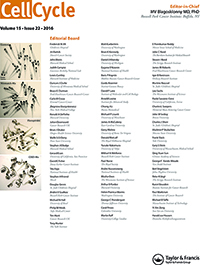 The University of Tokyo is investigating a 2011 stem cell paper in Cell Cycle, recently retracted over irregularities in four figures.
The University of Tokyo is investigating a 2011 stem cell paper in Cell Cycle, recently retracted over irregularities in four figures.
The university has confirmed there is an investigation, but would not specify which paper it concerned; the corresponding author on the paper, however, confirmed to us that it is the focus of the investigation.
In the retraction notice, published Nov. 1, the journal wrote:
We are now cognizant of irregularities, as identified by the authors, in figures 2A, 3B, 5C, and 4D of the above work that are relevant to its results. The authors report that these errors directly affect the interpretations of the paper, warranting its retraction.
We note that we received, peer-reviewed, accepted, and published the article in good faith.
The Mainichi, the English website of the daily Mainichi Shimbun newspaper, reports that the University of Tokyo – where five of the co-authors are based — is investigating what it called “suspected misconduct” after receiving anonymous tips:
According to the university, it received anonymous letters twice, in September and October, accusing the team of research misconduct. The university began a preliminary inquiry over the matter on Oct. 13 and decided on Nov. 4 that the panel would carry out a detailed investigation. The majority of the panel members will be third-party experts, and the body is expected to reach a conclusion within six months.
The Mainichi reported that the university has not revealed which paper or researchers it was investigating, but pointed to the Cell Cycle paper, titled “Polypyrimidine tract-binding protein regulates the cell cycle through IRES-dependent translation of CDK11 in mouse embryonic stem cells,” as a possibility. The university’s public relations group confirmed to us that there was an ongoing investigation, but declined further comment.
However, we spoke on the phone with Nobuaki Yoshida, the corresponding author of the Cell Cycle paper, which purported to show the effect of an RNA-binding protein on early mouse development. Yoshida confirmed that it was the paper in question.
Yoshida said he said he couldn’t go into any details while the investigation was ongoing, but did deny that there was any deliberate falsification, telling us:
Mainichi is not correct, I can say.
When we asked him what had happened, he told us:
Simply, we put the wrong figure, something like that. […] We didn’t do any artificial one or something like that. Simply mistake, I can say.
I cannot say anything now because it is a university matter, so please understand my situation. […] So after university decision is made, I can say everything, of course.
He also told us that he had submitted the retraction to Cell Cycle before the University of Tokyo began its investigation.
The paper has been the subject of discussion on PubPeer since earlier this year, after anonymous commenters flagged some of the figures.
In a comment marked as coming from one of the study authors, the researcher says one figure had been “mistakenly duplicated” and the other artifact was the result of gel splicing, which they had neglected to mention. The post included what the team said was the original data and indicated they were going to contact Cell Cycle:
We very much appreciate your time to dedicate to our paper. We agree with your indications and are going to contact with an editor of the journal…We deeply apologize for any confusions caused by our error or poor explanation for figures.
However, commenters pointed out further issues in the new figure as well as other figures in the original paper, including another instance of apparent duplication. Another comment on October 7 signed “corresponding author” did not deny the further issues:
Thank you very much for pointing out issues of our paper. After careful consideration among all authors, we have decided, with regret, to retract this paper and asked the editorial board of Cell Cycle to precede retraction on September 27. The proceeding is currently under estimations in the editorial board of Cell Cycle. We will let you know here again as soon as the final decision will be made.
We deeply regret this circumstance and apologize for any inconvenience that may have resulted from its publication.
The paper was retracted on November 1, five years to the day after its original publication. It has been cited 19 times, according to Clarivate Analytics’ Web of Science, formerly part of Thomson Reuters.
Hat tip: World Fluctuation Watch
Like Retraction Watch? Consider making a tax-deductible contribution to support our growth. You can also follow us on Twitter, like us on Facebook, add us to your RSS reader, sign up on our homepage for an email every time there’s a new post, or subscribe to our daily digest. Click here to review our Comments Policy. For a sneak peek at what we’re working on, click here.